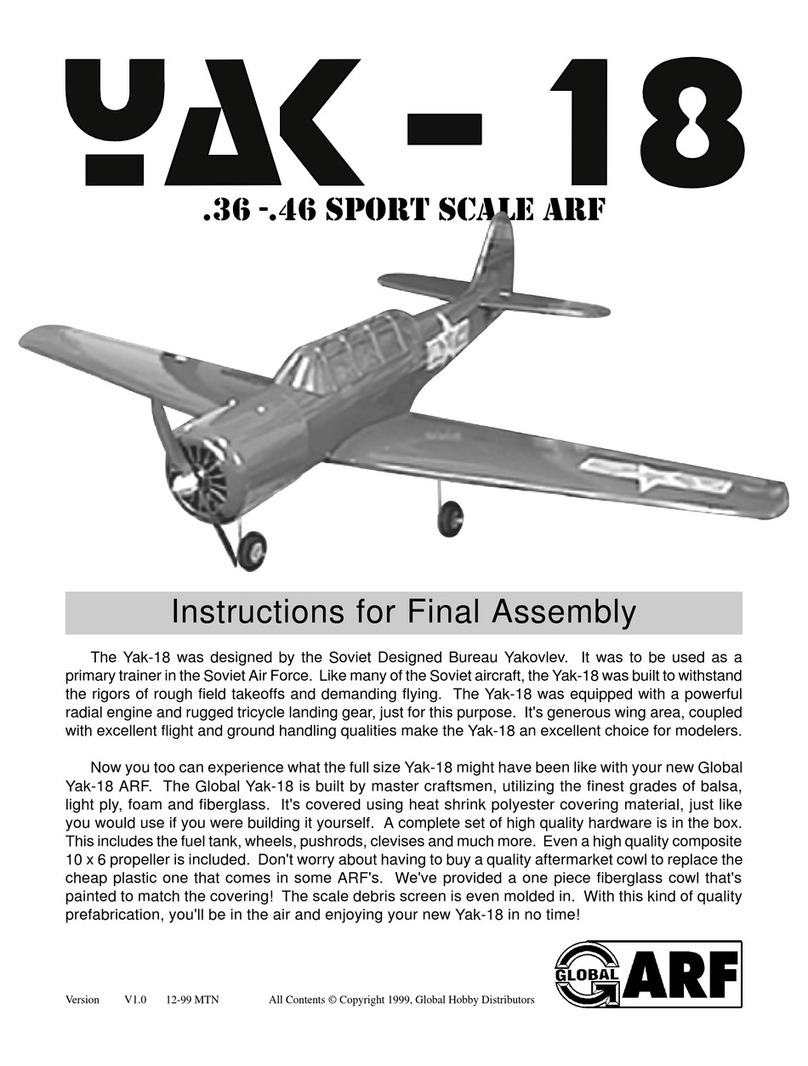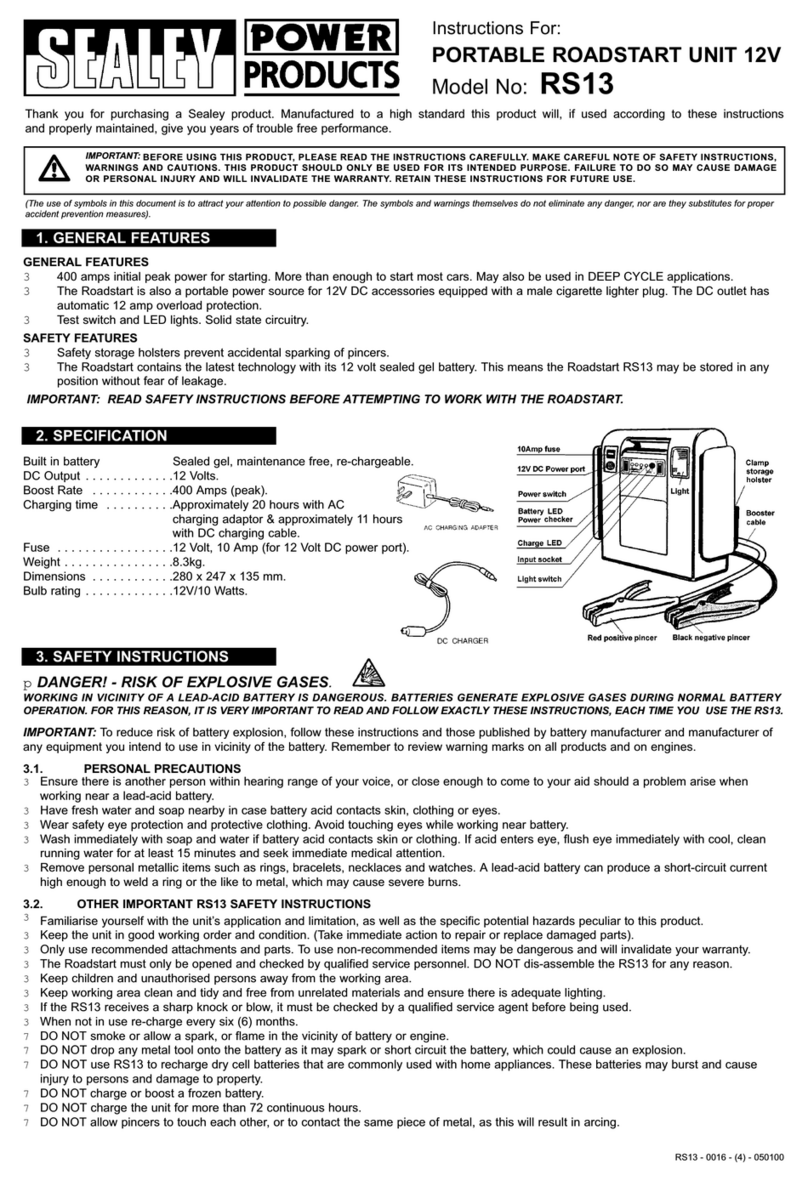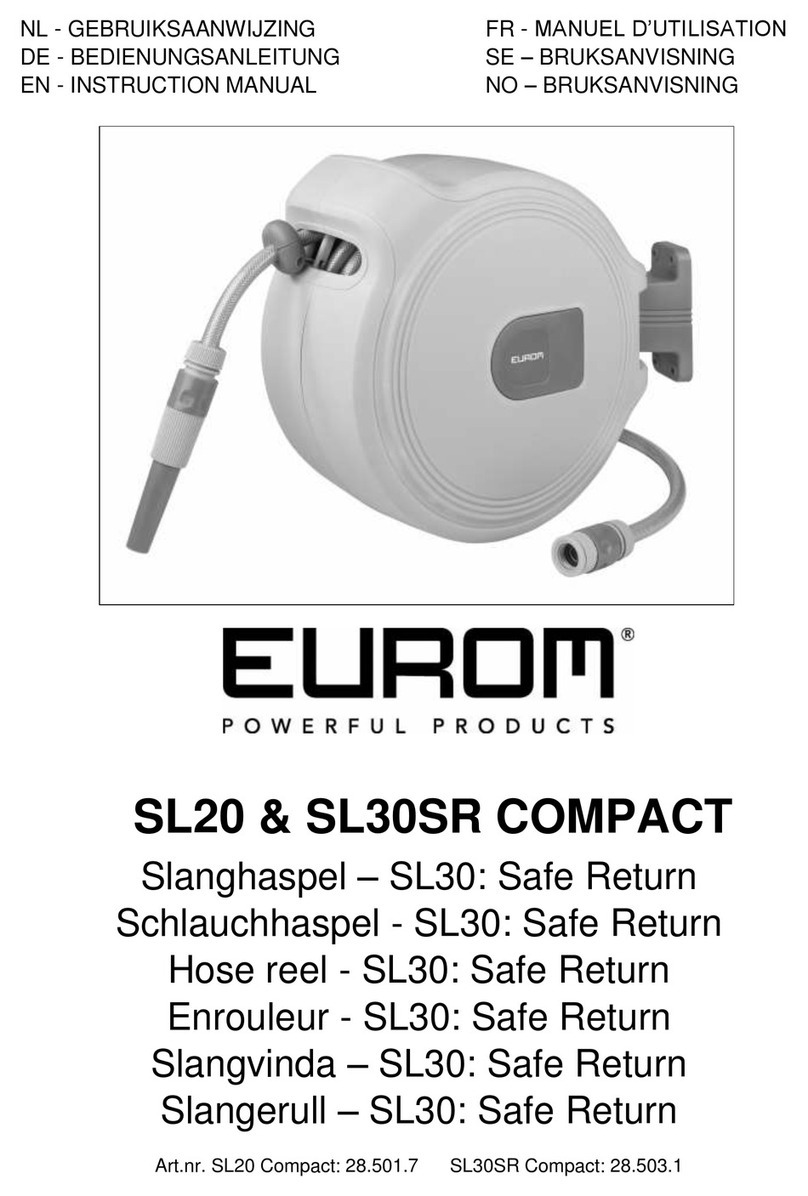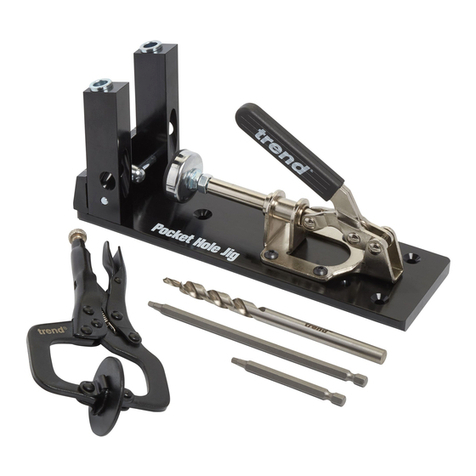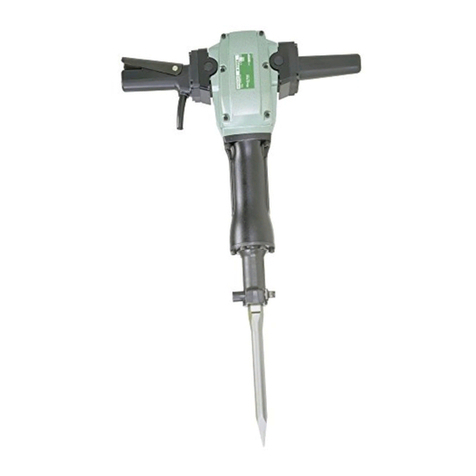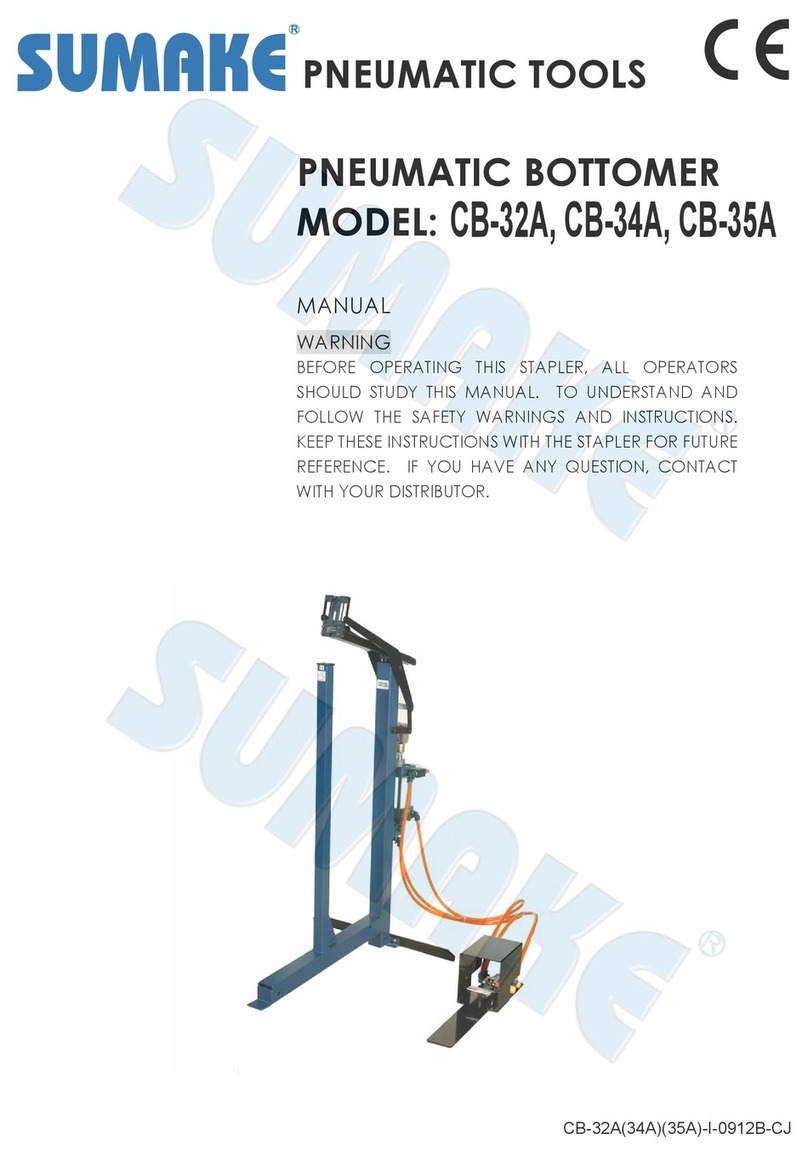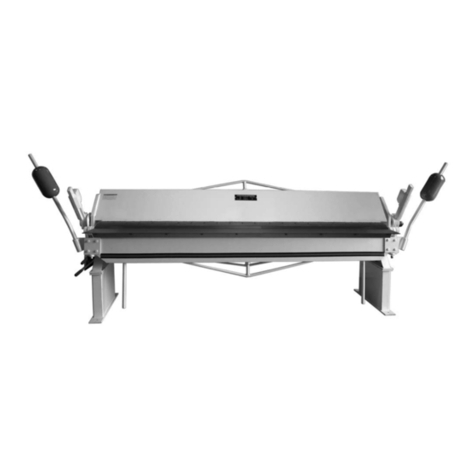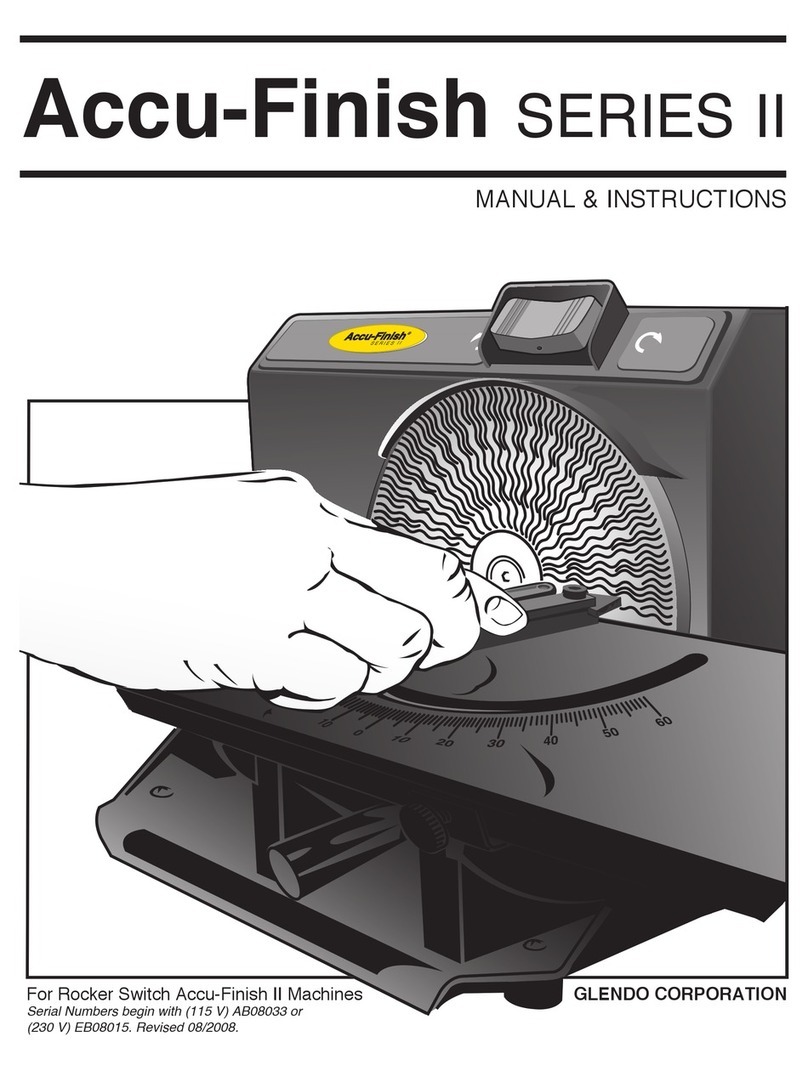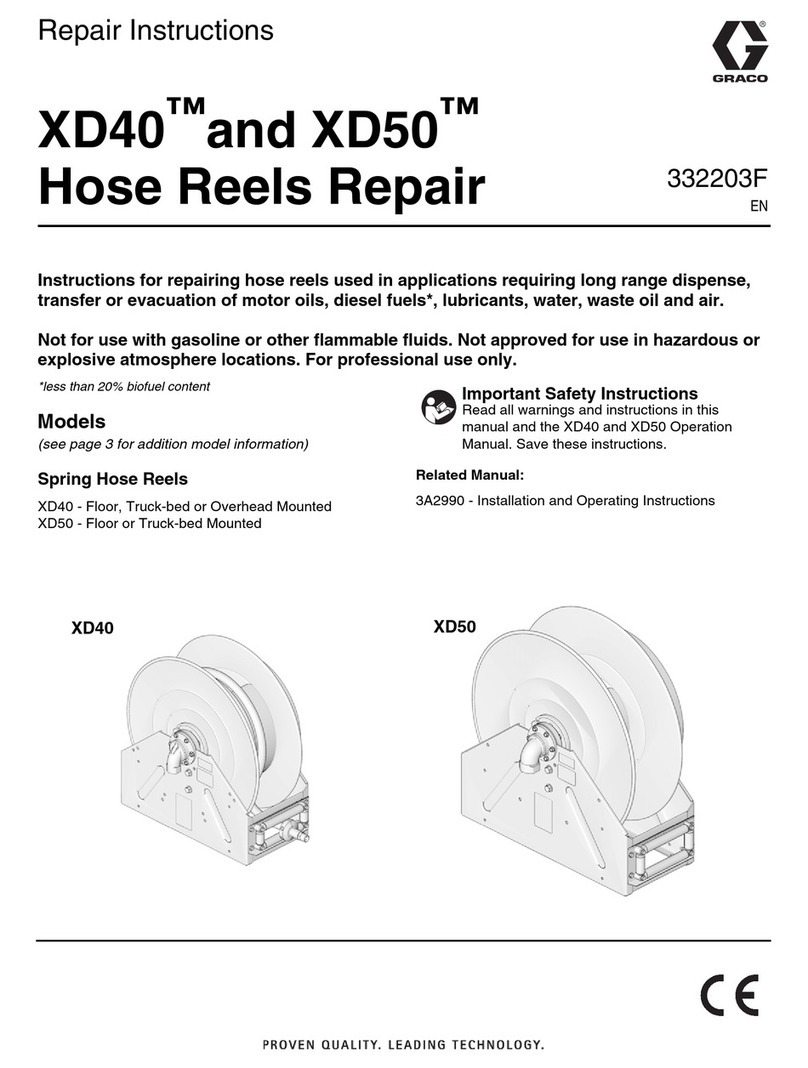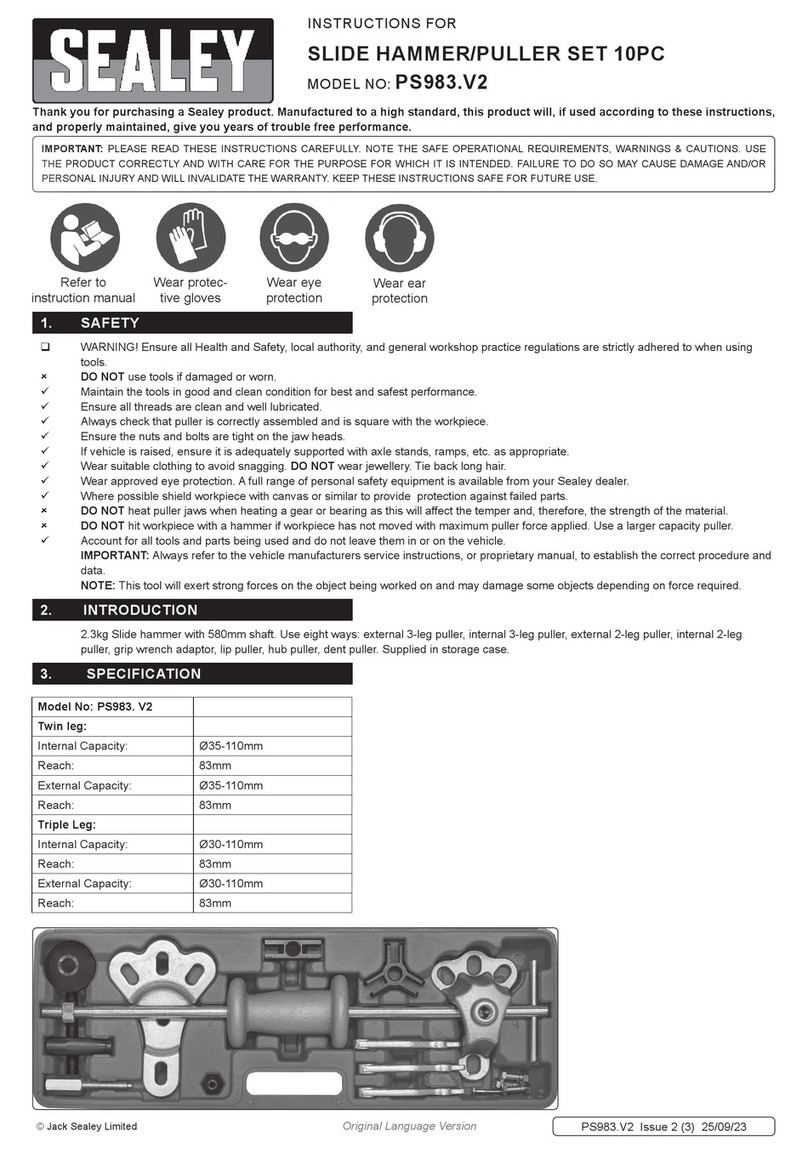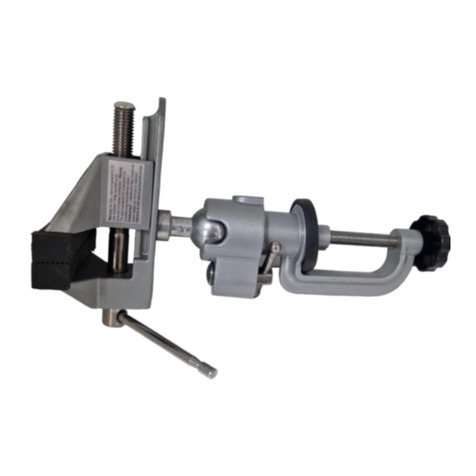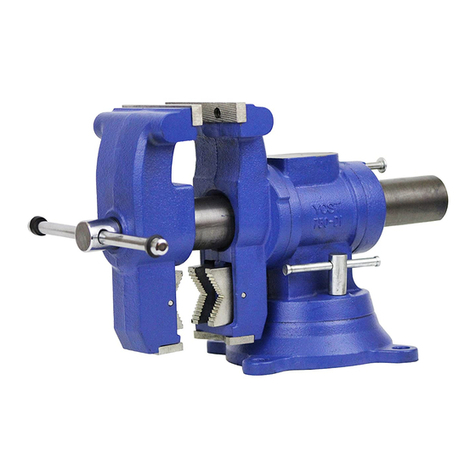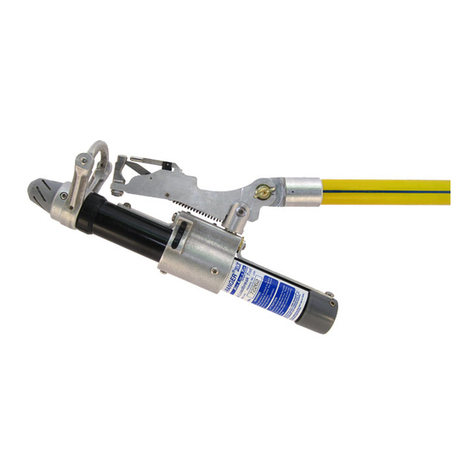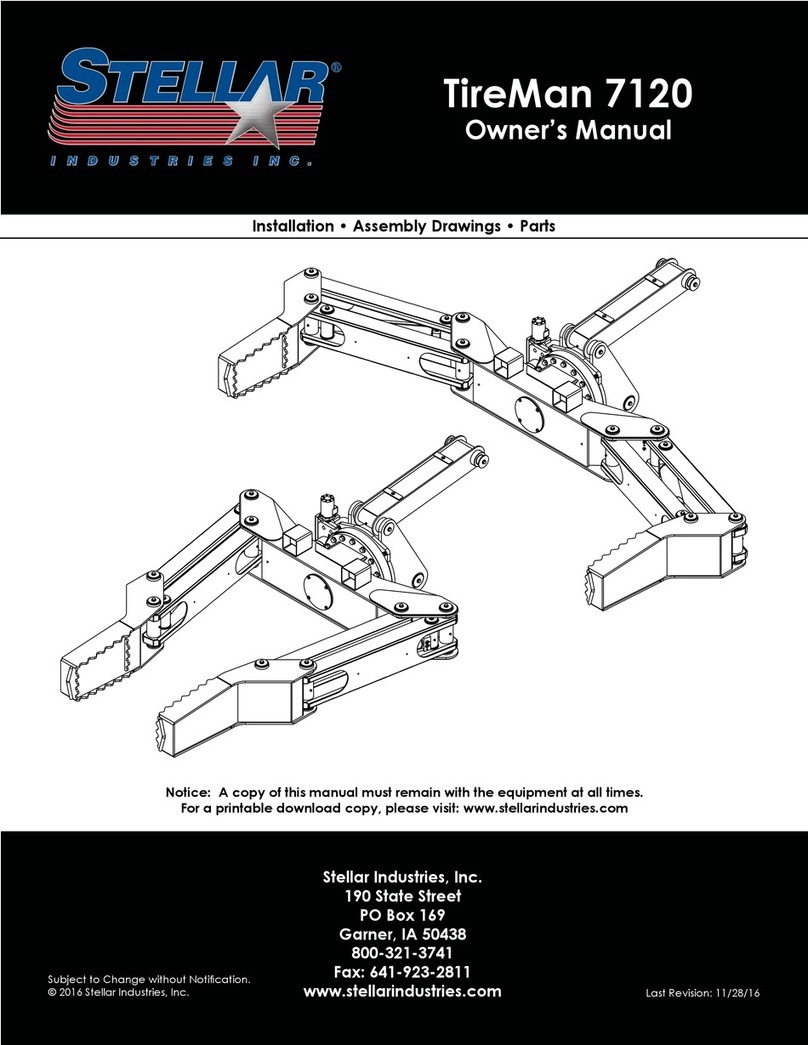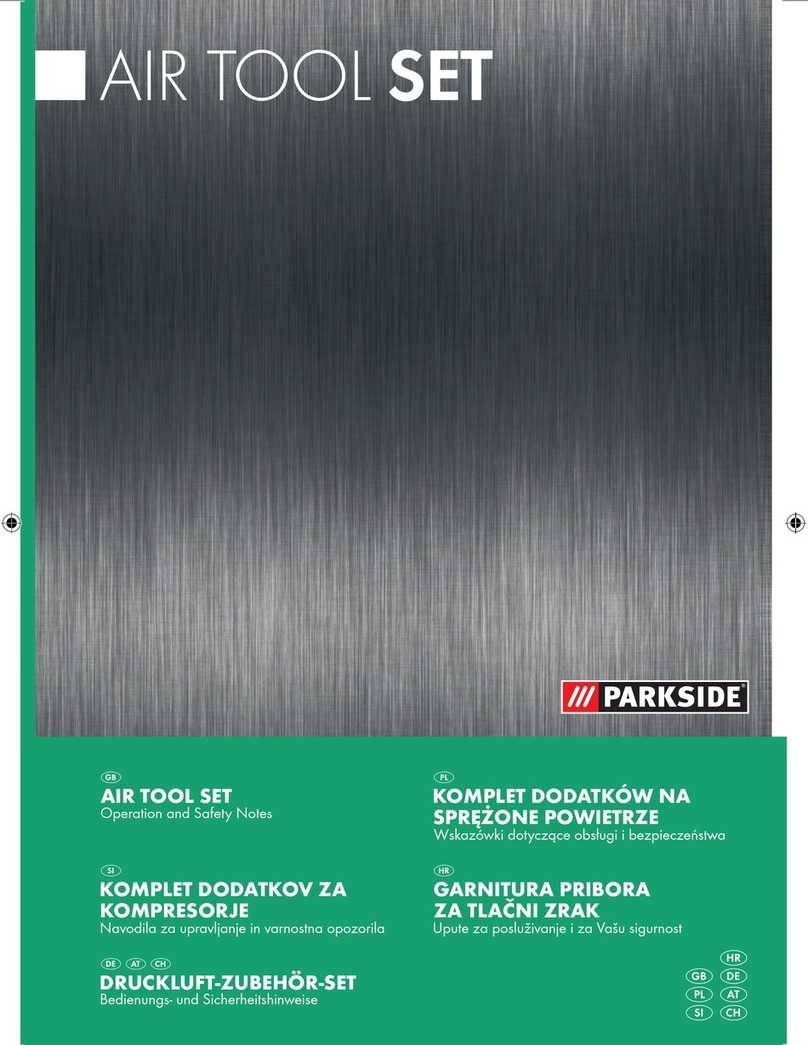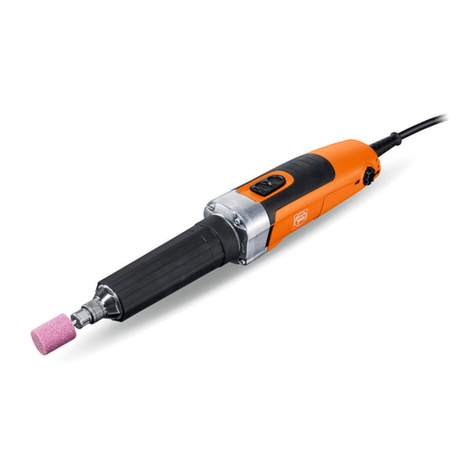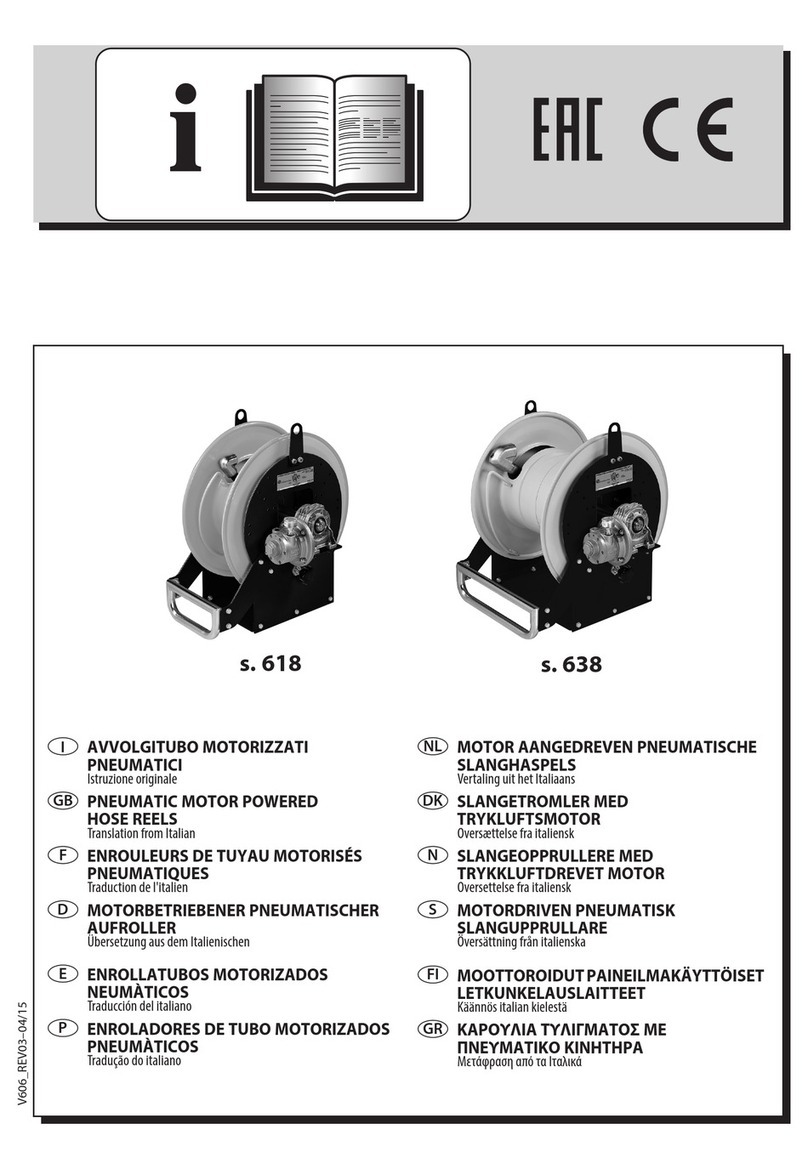Global Hobby Kwik Fly II ARF User manual

1
Need help or have any questions? Call us at 1-714-963-0329 or send us an e-mail at service@globalhobby.net
The Global Kwik Fly II ARF is distributed exclusively by
Global Hobby Distributors 18480 Bandilier Circle,
Fountain Valley, CA 92708
All contents copyright © 2003, Global Hobby
Distributors Version V1.0 February 2003
Kit Product Number 125822
INSTRUCTIONS FOR FINAL ASSEMBLY
Specifications:
●Wing Span: 66.5 Inches
●Wing Area: 830 Square Inches
●Length: 52.5 Inches
●Weight RTF: 8 - 9 Pounds
●Wing Loading: 22 - 25 Ounces Per Square Foot
●Functions: Ailerons, Elevator, Rudder, Throttle & Optional Flap
●Power: .61 - .91 2-Stroke or .80 - .91 4-stroke
●Radio: 4 - 5 Channel w/5 - 6 Standard Ball Bearing Servos

2Visit our website at http://www.globalhobby.com or for Customer Service at http://globalservices.globalhobby.com
TABLE OF CONTENTS
This R/C airplane is not a toy! If misused or abused, it can cause serious bodily injury and/or damage to property. Fly only
in open areas and preferably at a dedicated R/C flying site. We suggest having a qualified instructor carefully inspect your
airplane before its first flight. Please carefully read and follow all instructions included with this airplane, your radio control
system and any other components purchased separately.
SAFETY WARNING
OUR GUARANTEE
Global guarantees this kit to be free from defects in both material and workmanship, at the date of purchase. This does not cover any component
parts damaged by use, misuse or modification. In no case shall Global's liability exceed the original cost of the purchased kit.
In that Global has no control over the final assembly or material used for final assembly, no liability shall be assumed for any damage resulting from
the use by the user of the final user-assembled product. By the act of using the final user-assembled product, the user accepts all resulting liability.
FOR YOUR INFORMATION To make your modeling experience totally enjoyable, we recommend that you get experienced,
knowledgeable help with assembly and during your first flights. Your local hobby shop has information about flying clubs in
your area whose membership includes qualified instructors. If there is no hobby shop in your area, we recommend that you
contact the AMA at the address below. They will be able to help you locate a flying field near you.
Academy of Model Aeronautics
5151 East Memorial Drive
Muncie IN 47302-9252
(800) 435-9262
www.modelaircraft.org
Safety Warning ............................................................................................... 2
Introduction ..................................................................................................... 3
Section 1: Our Recommendations .................................................... 4
Section 2: Tools and Supplies Required .......................................... 5
Section 3: Kit Contents ..................................................................... 5
Section 4: Replacement Parts .......................................................... 7
Section 5: A Note About Covering .................................................... 7
Section 6: Wing Assembly ................................................................ 8
Section 7: Stabilizer Installation ...................................................... 10
Section 8: Control Surface Hinging ................................................ 13
Section 9: Main Landing Gear Installation ..................................... 14
Section 10: Nose Gear Installation ................................................. 16
Section 11: Engine Installation ....................................................... 17
Section 12: Fuel Tank Assembly & Installation .............................. 20
Section 13: Servo Installation ......................................................... 22
Section 14: Throttle Linkage Installation ........................................ 24
Section 15: Elevator Control System Installation ........................... 25
Section 16: Rudder Control System Installation ............................ 28
Section 17: Aileron Control System Installation ............................. 30
Section 18: Center-Flap Control System Installation ..................... 31
Section 19: Final Assembly ............................................................. 33
Section 20: Balancing the Kwik Fly II ARF .....................................36
Section 21: Lateral Balancing the Kwik Fly II ARF ......................... 37
Section 22: Control Throws............................................................. 37
Section 23: Preflight Check & Safety ............................................. 38
Section 24: Flying the Kwik Fly II ARF ........................................... 39
Section 25: Kwik Fly II ARF Trimming Chart .................................. 40
Product Evaluation Sheet ............................................................................ 43

3
Need help or have any questions? Call us at 1-714-963-0329 or send us an e-mail at service@globalhobby.net
This instruction manual is designed to guide you through the entire final assembly process of your new airplane in the
least amount of time possible. Along the way you'll learn how to properly assemble your new airplane and also learn
tips that will help you in the future. We have listed some of our recommendations below. Please read through them
before beginning assembly.
●Please read through each step before beginning
assembly. You should find the layout very complete
and straightforward. Our goal is to guide you through
assembly without any of the headaches and hassles
that you might expect.
●There are check boxes next to each step. After you
complete a step, check off the box. This will help
prevent you from losing your place.
●Cover your work table with brown paper or a soft cloth,
both to protect the table and to protect the parts.
●Keep a couple of small bowls or jars handy to put the
small parts in after you open the accessory bags.
●We're all excited to get a new airplane in the air, but
take your time. This will ensure you build a straight,
strong and great flying airplane.
●If you come across this symbol ☞, it means that
this is an important point or an assembly hint.
If you should find a part missing or damaged, or have any questions about assembly, please
contact us at the address below:
Global Services
18480 Bandilier Circle
Fountain Valley CA 92708
Phone: (714) 963-0329 Fax: (714) 964-6236 E-mail: service@globalhobby.net
INTRODUCTION
Thank you for purchasing the Global Kwik Fly II ARF. Before completing the final assembly of your new
airplane, please carefully read through this instruction manual in its entirety. Doing so will ensure your success
the first time around!
Global Kwik Fly II ARF Features:
●Completely Prebuilt from Balsa, Light Plywood and Foam
●Classic, Great-Flying Design
●Expertly Covered with Real Heat-Shrink, Iron-On Covering Material
●Prepainted Fiberglass Cowling
●Durable Heavy-Duty Landing Gear Wires
●Center-Flap Option for Extra-Slow Landings
●Clear Molded Canopy
●All Hardware Included - Wheels, Fuel Tank, Engine Mount, Pushrods, Etc.
●Fast & Easy Assembly - Over 60 High-Resolution Digital Photos Guide You
To serve your needs better, please include your email address with any correspondence you send to us. Your email
address will be added to our Customer Service Database so you will automatically receive free updates and tech
notices for your particular product. You will also receive repair status updates (if applicable) and other important
information about your product as it becomes available.
IMPORTANT INFORMATION ABOUT YOUR EMAIL ADDRESS
Global Hobby Distributors will not disclose the information it collects to outside parties. Global Hobby Distributors does not sell,
trade, or rent your personal information to others . Your privacy is important to us.
Visit Our Website
http://globalservices.globalhobby.com

4Visit our website at http://www.globalhobby.com or for Customer Service at http://globalservices.globalhobby.com
Here's What We Used to Finish Our Kwik Fly II ARF:
This section describes our recommendations to help you in deciding which types of accessories to purchase for your new
Global Kwik Fly II ARF. These suggestions are not set in stone, but they should provide you with a good starting point.
SECTION 1: OUR RECOMMENDATIONS
What Engine Should I Use?
The Kwik Fly II will fly great on a variety of engines, so which engine you choose really depends on how you want to fly the
airplane and on personal preference. For general sport flying, a .61 two stroke or .80 four stroke would be an ideal choice.
Either of these engines will provide good overall performance and will pull the airplane through most aerobatic maneuvers
with ease. Both engines can be mounted sideways and still use their stock mufflers, although the .61 size two stroke
engine will require the use of a muffler extension so the muffler will clear the bottom of the fuselage.
For all-out aerobatics a .91 two stroke or .91 four stroke would be a great choice. Either of these engines will provide an
excellent power-to-weight ratio, resulting in nearly unlimited vertical performance. Both engines can be mounted sideways
and still use their stock mufflers, although the .91 size two stroke will require the use of a muffler extension so the muffler
will clear the bottom of the fuselage.
What Servos Should I Use?
There really is no reason to go overboard on high-priced, ultra-precision servos. A good, standard, dual ball bearing servo
with a minimum of 40 ounces of torque will work well on the flight-control surfaces and a standard bushing servo will be
good for use on the throttle and the center-flap.
Do I Need To Use the Center-Flap?
The center-flap is optional, so, no, you don't need to use it. If you decide you want to make it functional you will need one
extra standard servo and a 5 channel radio control system to operate it. Hardware is included to hinge the center-flap and
connect it to the servo. If you choose not to use the center-flap, it can be locked into place using the hardware included.
What Else Do I Need?
The Kwik Fly II includes all of the hardware you'll need to finish the airplane. You will need some basic building materials,
such as adhesives, protective foam rubber for your radio gear and fuel tubing. You will also need a couple of 12" servo
extensions and a Y-Harness to connect the two separate aileron servos. We've provided a comprehensive list below of the
items we used on the airplane shown in this instruction manual.
QTY. 1 210803 Magnum XL .61ARNV 2-Stroke Engine
QTY. 1 280153 Magnum Muffler Extension for XL .61ARNV Engine
QTY. 5 Cirrus Ball Bearing Standard Servos
QTY. 1 Cirrus Ball Bearing Standard Servo (Optional for Center-Flap Assembly)
QTY. 2 444713 Cirrus 12" Servo Extension Cord
QTY. 1 444728 Cirrus Y-Harness
QTY. 1 608660 APC 12 x 6 Composite Propeller
QTY. 1 115493 Thunderbolt R/C Long Glow Plug
QTY. 1 115923 Global XX Silicon Fuel Tubing
QTY. 1 868638 Dubro 1/4" Protective Foam Rubber
QTY. 1 592634 Williams Bros. Scale Sportsman Pilot (Optional)
IMPORTANT The part numbers listed for the Cirrus extension cords and Y-harness are compatible with Hitec and JR radio control
systems. These items are also available with connectors that are compatible with Futaba and Airtronics radio control systems.

5
Need help or have any questions? Call us at 1-714-963-0329 or send us an e-mail at service@globalhobby.net
❑Kwik Bond Thin C/A # 887500
❑Kwik Bond Thick C/A # 887510
❑Kwik Bond 5 Minute Epoxy # 887560
❑Kwik Bond 30 Minute Epoxy # 887565
❑Kwik Bond C/A Debonder # 887545
❑Pacer Z-42 Threadlocker # 339162
❑# 1 Phillips Head Screwdriver
❑# 2 Phillips Head Screwdriver
❑3mm Hex Wrench
❑Adjustable Wrench
❑Wire Cutters
❑Needle Nose Pliers
❑Excel Modeling Knife # 692801
❑Scissors
❑Electric Drill
❑Assorted Drill Bits
❑Dubro T-Pins # 567685
❑Ernst Airplane Stand # 223977
❑Rotary Tool w/Cutting Disc & Sanding Drum
❑Ruler
❑Pencil
❑Builder's Triangle
❑220 Grit Sandpaper w/Sanding Block
❑Masking Tape
❑Paper Towels
❑Rubbing Alcohol
❑NHP Epoxy Mixing Sticks # 864204
❑NHP Epoxy Mixing Cups # 864205
SECTION 2: TOOLS AND SUPPLIES REQUIRED
The tools and supplies listed below will be necessary to finish the final assembly of your Kwik Fly II ARF. We suggest
having these items on-hand before beginning assembly.
SECTION 3: KIT CONTENTS
We have organized the parts as they come out of the box for easier identification during assembly. Before you begin
assembly, group the parts as we list them below. This will ensure that you have all of the parts before you begin assembly
and it will also help you become familiar with each part. If you find any parts missing or damaged, please contact us below:
Global Services
18480 Bandilier Circle
Fountain Valley, CA 92708
Phone: (714) 963-0329 Fax: (714) 964-6236 E-mail: service@globalhobby.net
On the Web
http://globalservices.globalhobby.com
AIRFRAME ASSEMBLIES
❑(1) Fuselage
❑(1) Right Wing Panel w/Aileron
❑(1) Left Wing Panel w/Aileron
❑(1) Horizontal Stabilizer w/Elevator Halves
❑(1) Vertical Stabilizer w/Rudder
Continued On Next Page
AILERON CONTROL SYSTEM
❑(2) 3-1/8" Threaded Wires w/90º Bend
❑(2) Nylon Control Horns w/Backplates
❑(4) 2mm x 30mm Machine Screws
❑(2) Nylon Clevises
❑(2) Nylon 90º Snap Keepers
❑(8) C/A Style Hinges
THROTTLE CONTROL SYSTEM
❑(1) 18" Pushrod Wire w/Z-Bend
❑(1) Adjustable Servo Connector Assembly

6Visit our website at http://www.globalhobby.com or for Customer Service at http://globalservices.globalhobby.com
MAIN LANDING GEAR ASSEMBLY
❑(2) Prebent Main Gear Wires
❑(2) Main Gear Wheels
❑(6) Nylon Landing Gear Straps
❑(2) 4mm Nylon Spacers
❑(2) 4mm Wheel Collars w/Set Screws
❑(12) 3mm x 12mm Wood Screws
ELEVATOR CONTROL SYSTEM
❑(2) 23-3/4" Nylon Pushrods
❑(2) 5-7/8" Threaded Pushrod Wires
❑(2) Nylon Control Horns w/Backplates
❑(4) 2mm x 15mm Machine Screws
❑(3) Nylon Clevises
❑(1) Nylon Pushrod Joiner Plate
❑(1) 2mm x 20mm Machine Screw
❑(2) 2mm x 10mm Wood Screws
❑(4) 2mm Flat Washers
❑(1) 2mm Hex Nut
❑(6) C/A Style Hinges
RUDDER CONTROL SYSTEM
❑(2) 23-3/4" Nylon Pushrod
❑(2) 5-7/8" Threaded Pushrod Wires
❑(1) Nylon Control Horn w/Backplate
❑(2) 2mm x 15mm Machine Screws
❑(2) Nylon Clevises
❑(3) C/A Style Hinges
MISCELLANEOUS WING PARTS
❑(1) Hardwood Wing Joiner
❑(2) 5mm x 50mm Machine Screws
❑(2) 5mm Flat Washers
❑(1) Center-Flap
❑(1) Plywood Center-Flap Servo Tray
❑(1) Nylon Control Horn w/Backplate (small)
❑(2) 2mm x 20mm Machine Screws
❑(1) 5-7/8" Threaded Pushrod Wire
❑(1) Nylon Clevis
❑(1) Nylon 90º Snap Keeper
❑(4) C/A Style Hinges
MISCELLANEOUS FUSELAGE PARTS
❑(1) Prepainted Molded Fiberglass Cowling
❑(1) Clear Molded Canopy
❑(1) Spinner Assembly w/Wood Screws
❑(4) 3mm x 10mm Wood Screws
❑(4) 3mm Flat Washers
FUEL TANK ASSEMBLY
❑(1) 360cc Fuel Tank
❑(1) Large Diameter Metal Plate
❑(1) Small Diameter Metal Plate
❑(1) Rubber Stopper
❑(1) Fuel Pick-Up "Clunk"
❑(1) 3mm x 20mm Machine Screw
❑(1) Silicon Fuel Tubing
❑(2) Aluminum Tubing
NOSE GEAR ASSEMBLY
❑(1) Prebent Nose Gear Wire
❑(1) Nose Gear Wheel
❑(1) Nylon Steering Arm w/Set Screw
❑(2) 4mm Nylon Spacers
❑(2) 4mm Wheel Collars w/Set Screws
❑(1) 18" Pushrod Wire w/Z-Bend
❑(1) Adjustable Servo Connector Assembly
ENGINE MOUNT ASSEMBLY
❑(2) Engine Mounting Beams
❑(4) 4mm x 20mm Socket-Cap Screws
❑(4) 4mm Blind Nuts
❑(4) 4mm x 25mm Socket-Cap Screws
❑(4) 4mm Lock Nuts
❑(12) 4mm Flat Washers
MISCELLANEOUS PARTS
❑(1) Length of Clear Tubing
❑(1) Decal Set
❑(1) Adhesive Striping Tape
To convert inches into millimeters: Inches x 25.4 = mm
To convert millimeters into inches: Millimeters / 25.4 = in
KIT CONTENTS CONTINUED....

7
Need help or have any questions? Call us at 1-714-963-0329 or send us an e-mail at service@globalhobby.net
Global stocks a complete line of replacement parts for your Global Kwik Fly II ARF. Listed below are the replacement
parts that are available along with their respective part numbers for easy ordering convenience. We suggest ordering
directly from your local dealer. If your dealer does not stock Global products, you can order directly from us at the address
shown below:
SECTION 4: REPLACEMENT PARTS
The covering material used on the Kwik Fly II ARF is real iron-on, heat-shrink covering material, not cheap "shelf
paper." Because of this, it is possible with heat and humidity changes that the covering on your airplane may wrinkle
or sag. This trait is inherent in all types of heat-shrink material. To remove any wrinkles that might be visible you will
need to purchase, or borrow from a fellow modeler, a heat iron. If you need to purchase one, the Global Heat Sealing
Iron # 360900 is recommended.
Follow this simple procedure to remove the wrinkles:
❑Plug in and turn on the sealing iron to the medium-high temperature setting. Allow the iron to heat up for approximately
5 - 7 minutes.
❑After the iron has reached temperature, lightly apply the iron to the wrinkled section of the covering. Move the iron
slowly over the wrinkled section until the covering tightens and the wrinkles disappear. You will notice that the color of the
covering will darken when it is heated. When the covering cools back down, it will return to its normal color.
☞If the color layer smears from any of the seams the temperature of the iron is too hot. Turn the temperature dial down
and wait about 5 minutes for the iron to adjust to the lower temperature. You can remove any excess color streaks using
a paper towel soaked with a small quantity of Acetone.
WARNING
We do not suggest storing your airplane in an extremely hot environment (like the back of your car in direct
sunlight) for any length of time. The extreme heat could cause the covering material to wrinkle or sag and
possibly damage the clear canopy, and the fragile components of the radio system.
SECTION 5: A NOTE ABOUT COVERING
Global Services
18480 Bandilier Circle
Fountain Valley CA 92708
Phone: (714) 963-0329 Fax: (714) 964-6236
On the Web
http://globalservices.globalhobby.com
Global Kwik Fly II ARF - Complete .................... 125822
Instruction Manual ............................................. 120435
Wing Set ............................................................ 120436
Fuselage Set ..................................................... 120437
Stabilizer Set ..................................................... 120438
Fiberglass Cowling ............................................ 120439
Clear Canopy ..................................................... 120440
Engine Mount Set .............................................. 120441
Hardware Set ..................................................... 120442
Fuel Tank Assembly ........................................... 120074
Decal Set ............................................................ 120443

8Visit our website at http://www.globalhobby.com or for Customer Service at http://globalservices.globalhobby.com
❑Kwik Bond 30 Minute Epoxy
❑Excel Modeling Knife
❑Ruler
❑Pencil
❑220 Grit Sandpaper w/Sanding Block
YOU'LL NEED THE FOLLOWING PARTS FROM THE KIT:
❑(1) Right Wing Panel w/Aileron
❑(1) Left Wing Panel w/Aileron
SECTION 6: WING ASSEMBLY
❑(1) Hardwood Wing Joiner
YOU'LL NEED THE FOLLOWING TOOLS AND SUPPLIES:
❑Masking Tape
❑Paper Towels
❑Rubbing Alcohol
❑NHP Epoxy Mixing Sticks
❑NHP Epoxy Mixing Cups
Step 1: Installing the Wing Joiner
❑Remove the aileron and hinges from each of the two wing panels and set them aside for now.
❑Using a modeling knife, cut away and remove the excess
covering material that overlaps onto the root ribs of each wing
panel, leaving about 1/16" overlapped so it does not pull away.
IMPORTANT It's very important to the integrity of the wing
center section joint that you remove as much covering material
from the root ribs as possible.
❑Use a ruler and a pencil to locate and draw a vertical
centerline on each side of the hardwood wing joiner.
❑Test-fit the wing joiner into each wing panel. It should
slide easily into each panel up to the centerline you drew.
☞If it does not fit properly, use 220 grit sandpaper with a
sanding block to lightly sand the edges and tips of the joiner,
until you are satisfied with the fit.
IMPORTANT The wing joiner is straight. There is no top
or bottom.

9
Need help or have any questions? Call us at 1-714-963-0329 or send us an e-mail at service@globalhobby.net
❑Slide both wing panels together with the wing joiner
temporarily installed (without using glue).
❑Look carefully at the center section joint: the wing panels should fit together tightly with few or no gaps in the joint.
☞If the wing panels do not fit together properly, remove the wing joiner and use 220 grit sandpaper with a sanding
block to lightly sand the edges and tips of the joiner, until you are satisfied with the fit.
❑When satisfied with the fit, pull the wing panels apart and remove the wing joiner.
❑Mix a generous amount of 30 minute epoxy. Working with only one wing panel for now, apply a thin layer of epoxy
inside the wing joiner box and to only half of the wing joiner. Make sure to cover the top and bottom, as well as the sides,
and use enough epoxy to fill any gaps.
❑Slide the wing joiner into the wing panel up to its centerline. Quickly remove any excess epoxy using a paper towel and
rubbing alcohol, and allow the epoxy to set up before proceeding.
❑After the epoxy has set up, test-fit both wing panels together again to double-check that they still fit together properly.
Check the leading and trailing edges, too. It's important that they be even with each other.
❑Mix a generous amount of 30 minute epoxy and apply a thin layer to the exposed half of the wing joiner, the inside of
the wing joiner box in the second wing panel, and the entire surface of BOTH root ribs. Make sure to use enough epoxy
to fill any gaps.
❑Slide the two wing panels together and realign them. Quickly wipe away any excess epoxy using a paper towel and
rubbing alcohol, and use pieces of masking tape to hold the two wing panels aligned until the epoxy fully cures.
Step 2: Joining the Wing Panels
❑Apply a long strip of masking tape to the top and bottom
edges of the root rib on each wing panel.
☞The masking tape will prevent excess epoxy from getting
onto the wing panels when you join them.
❑Once the epoxy has fully cured, remove the masking tape and double-check the center section joint. If any gaps are
present, mix a small amount of 30 minute epoxy and carefully fill any remaining gaps. Quickly remove any excess epoxy
using a paper towel and rubbing alcohol, and allow the epoxy to thoroughly cure.
Step 3: Checking the Center Section Joint

10 Visit our website at http://www.globalhobby.com or for Customer Service at http://globalservices.globalhobby.com
❑Kwik Bond 30 Minute Epoxy
❑# 2 Phillips Head Screwdriver
❑Excel Modeling Knife
❑Dubro T-Pins
❑Ernst Airplane Stand
❑Ruler
❑Pencil
YOU'LL NEED THE FOLLOWING PARTS FROM THE KIT:
❑(1) Fuselage
❑(1) Horizontal Stabilizer w/Elevator Halves
❑(1) Vertical Stabilizer w/Rudder
SECTION 7: STABILIZER INSTALLATION
❑(2) 5mm x 50mm Machine Screws
❑(2) 5mm Flat Washers
YOU'LL NEED THE FOLLOWING TOOLS AND SUPPLIES:
❑Builder's Triangle
❑220 Grit Sandpaper w/Sanding Block
❑Masking Tape
❑Paper Towels
❑Rubbing Alcohol
❑NHP Epoxy Mixing Sticks
❑NHP Epoxy Mixing Cups
Step 1: Mounting the Wing
❑Using a modeling knife, cut away and remove the
covering material from over the top and bottom of the two
predrilled holes in the trailing edge of the wing. The holes are
located 3/4" in front of the trailing edge and 1-1/4" out from
the centerline.
❑Align the predrilled holes in the wing with the preinstalled
blind nuts in the wing mounting block inside the fuselage.
Secure the wing into place using two 5mm x 50mm machine
screws and two 5mm flat washers.
☞Don't overtighten the screws. You don't want to crush
the wing.
Step 2: Aligning & Installing the Horizontal Stabilizer
❑Remove the elevator halves and hinges from the horizontal stabilizer and set them aside for now.
IMPORTANT The gap between the trailing edge of the wing and the back of the wing saddle is normal. This area will be
covered by the center-flap when it's hinged later.
❑With the fuselage upside down, place the wing into the wing saddle and push the trailing edge down into place.

11
Need help or have any questions? Call us at 1-714-963-0329 or send us an e-mail at service@globalhobby.net
❑Using a modeling knife, cut away and remove the covering
material from over the horizontal and vertical stabilizer
mounting slots in the back of the fuselage.
❑Using a ruler and a pencil, measure and draw a vertical
centerline across the top of the horizontal stabilizer.
❑Carefully center the stabilizer from side-to-side using the
centerline you drew as a guide. It should be centered down
the middle of the vertical stabilizer mounting slot when viewed
from the top.
❑When satisfied with the alignment, hold only the trailing
edge of the stabilizer in position using a T-Pin.
IMPORTANT The front of the stabilizer should be able to
pivot from side to side and the back should stay firmly in place
and aligned.
❑Carefully slide the stabilizer into the mounting slot, making sure that the trailing edge of the stabilizer, at the bottom, is
even with the back edge of the fuselage.
IMPORTANT The trailing edge of the stabilizer must not extend past the back of the fuselage or the rudder won't line up
properly when it's hinged later.
❑With the wing mounted to the fuselage, use a ruler to
measure the distance between the tips of the stabilizer and
the tips of the wing. Pivot the front of the stabilizer until both
of these measurements are equal.

12 Visit our website at http://www.globalhobby.com or for Customer Service at http://globalservices.globalhobby.com
❑When you are satisfied that the stabilizer is square to the wing, use a pencil to draw a couple of marks on each side of
the front of the stabilizer where it and the fuselage sides meet, then use a couple of pieces of masking tape to hold the
stabilizer firmly in place and aligned.
❑With the stabilizer held firmly in place, look from the front
of the airplane at both the wing and the stabilizer. When
aligned properly, the stabilizer should be parallel to the wing.
☞If the stabilizer is out of alignment, remove it and use 220
grit sandpaper with a sanding block to sand down the higher
side of the stabilizer mounting slot, then reinstall the stabilizer
and check the alignment once more. Repeat this procedure
until you are satisfied with the alignment.
❑With the stabilizer properly aligned, use a pencil to draw a line on each side of the stabilizer where it meets the
fuselage sides. Do this on both the top and the bottom.
❑Remove the stabilizer. Using a modeling knife, carefully
cut away and remove the covering material from between the
lines you drew. Do this on both the top and the bottom.
WARNING When cutting through the covering to remove it,
cut with only enough pressure to cut through only the covering
itself. Cutting down into the balsa structure could weaken the
stabilizer and cause it to fail during flight.
❑Mix and apply a generous amount of 30 minute epoxy to ONLY the top and bottom gluing surfaces of the stabilizer.
IMPORTANT Because the stabilizer has to slide in place through the fuselage, apply epoxy only to the stabilizer. This will
prevent the epoxy from spreading over the entire length of one half of the stabilizer when you slide it into place.
❑Slide the stabilizer back into place and realign it, double-checking all of your measurements once more before the
epoxy sets up. Quickly remove the excess epoxy and use pieces of masking tape to hold the stabilizer in place until the
epoxy has fully cured.
❑After the epoxy has fully cured, remove the masking tape and look closely at the glue joint. If there are any gaps
between the stabilizer and the fuselage, fill them using 30 minute epoxy for added strength. Again, before the epoxy sets
up, remove any excess using a paper towel and rubbing alcohol.
Step 3: Aligning & Installing the Vertical Stabilizer
❑Remove the rudder and hinges from the vertical stabilizer
and set them aside for now.
❑Push the vertical stabilizer down into its mounting slot.
To align it properly, the stabilizer should be even with the
back edge of the fuselage and it should be pushed down
firmly. The dorsal fin should also be aligned with the middle
of the fuselage.
❑Using a builder's triangle, check to make sure that the
vertical stabilizer is aligned 90º to the horizontal stabilizer.

13
Need help or have any questions? Call us at 1-714-963-0329 or send us an e-mail at service@globalhobby.net
❑While holding the vertical stabilizer firmly in place, use a pencil to draw a line on each side of the stabilizer where it
meets the top of the fuselage.
❑Carefully draw an outline of the vertical stabilizer and the dorsal fin onto the top of the fuselage.
❑Remove the stabilizer. Using a modeling knife, carefully
cut away and remove the covering material from below the
lines you drew on the stabilizer. Also, remove any covering
material from the base of the stabilizer and dorsal fin, too.
❑Using a modeling knife, carefully cut away and remove
the covering material from inside the outline you drew on top
of the fuselage.
❑Apply a generous amount of 30 minute epoxy to the gluing surfaces of both the stabilizer and the stabilizer mounting
slot in the top of the fuselage. Apply epoxy inside the outline you drew on top of the fuselage and to the bottom of the dorsal
fin, too.
❑Push the stabilizer down into place and realign it, double-checking all of your measurements once more before the
epoxy sets up. Quickly remove the excess epoxy and use pieces of masking tape to hold the stabilizer in place until the
epoxy has fully cured.
❑Kwik Bond Thin C/A
❑Kwik Bond C/A Debonder
❑Excel Modeling Knife
YOU'LL NEED THE FOLLOWING PARTS FROM THE KIT:
❑(21) C/A Style Hinges
SECTION 8: CONTROL SURFACE HINGING
YOU'LL NEED THE FOLLOWING TOOLS AND SUPPLIES:
❑Ernst Airplane Stand
❑Paper Towels
Step 1: Hinging the Ailerons
For flutter-free control surfaces it is imperative that the hinges be glued in properly. This includes both having a tight
hinge gap and using plenty of thin C/A glue.
❑Center each of the hinges within its precut slot in both
ailerons. If you can't push the hinge in halfway, carefully cut
the slot deeper using a modeling knife.
❑Carefully glue each hinge into place using 5-6 drops of
thin C/A on each side of the hinge. Do not use thick C/A or
epoxy. Use only thin C/A for proper adhesion.
☞If any C/A gets onto the aileron, it can be removed
promptly using a paper towel soaked with a small quantity of
C/A Debonder.
❑(1) Center-Flap

14 Visit our website at http://www.globalhobby.com or for Customer Service at http://globalservices.globalhobby.com
❑Working with one aileron and wing panel for now, slide the aileron and its hinges into the precut hinge slots in the
trailing edge of the wing panel, making sure that the leading edge of the aileron is pushed firmly up against the trailing edge
of the wing panel and that the outer end of the aileron does not rub against the wing tip.
❑While holding the aileron tight against the wing panel,
pivot the aileron down about 45º and apply 5-6 drops of thin
C/A to the exposed area of each hinge. Turn the wing panel
over and repeat for the other side of the hinges.
☞Remove any C/A that may run down the hinge line using
C/A Debonder.
❑Allow the C/A to dry for about 15 minutes, then pivot the
aileron up and down to free up the hinges.
❑Repeat the previous procedures to hinge the second aileron.
IMPORTANT After the C/A has fully cured, gently grasp each aileron and pull on it like you are trying to pull out the
hinges. The hinges should hold securely. If one or more hinges feels loose, apply more C/A to the hinge(s) and allow it
to completely cure.
Step 2: Hinging the Center-Flap, Elevator Halves & Rudder
❑Hinge the center-flap, elevator halves and rudder using the same techniques as hinging the ailerons. The center-flap
is hinged using four hinges and the elevator halves and the rudder each use three hinges. When hinging the center-flap,
the outer ends of the center-flap should be equally spaced between the inside edges of the ailerons. When hinging the
elevator halves and the rudder, the outer ends of the control surfaces should not rub against the stabilizers. Remember,
after allowing the C/A to fully cure, pull on the control surfaces and the center-flap to check the integrity of the hinges.
❑# 2 Phillips Head Screwdriver
❑Excel Modeling Knife
❑Electric Drill
YOU'LL NEED THE FOLLOWING PARTS FROM THE KIT:
❑(2) Prebent Main Gear Wires
❑(2) Main Gear Wheels
❑(6) Nylon Landing Gear Straps
SECTION 9: MAIN LANDING GEAR INSTALLATION
❑(2) 4mm Nylon Spacers
❑(2) 4mm Wheel Collars w/Set Screws
❑(12) 3mm x 12mm Wood Screws
YOU'LL NEED THE FOLLOWING TOOLS AND SUPPLIES:
❑5/64" Drill Bit
❑Ruler
❑Pencil
Step 1: Installing the Landing Gear Wires
❑Using a modeling knife, cut away and remove the covering material from over the precut landing gear mounting slot in
the bottom of each wing half. Each slot is 4-1/8" long and 1/8" wide.
☞The slots are located 5" out from the wing centerline and 5-1/2" back from the leading edge.

15
Need help or have any questions? Call us at 1-714-963-0329 or send us an e-mail at service@globalhobby.net
❑Insert the 90º bend in one main gear wire into the
predrilled hole in one landing gear mounting slot.
❑Push the landing gear wire firmly down into the slot.
☞The top of the wire should be nearly flush with the bottom
of the wing.
❑The main gear wire is held in place using three nylon landing gear straps and six 3mm x 12mm wood screws. Position
three nylon straps over the landing gear wire, equal distances from each end of the wire.
❑While holding the nylon straps in place, use a pencil to mark the locations of the mounting screws onto the wing.
IMPORTANT Make sure the nylon straps are centered over the landing gear wire when you mark the positions of the
mounting screw holes. This will ensure the screws won't miss being installed in the hardwood landing gear mounting block.
❑Remove the nylon straps and drill six 5/64" diameter pilot holes into the wing.
WARNING Be careful not to drill through the top of the wing.
❑Install the landing gear straps using six 3mm x 12mm
wood screws.
Step 2: Installing the Main Gear Wheels
❑Slide one 4mm nylon spacer onto each axle followed
by one main gear wheel.
❑Secure each wheel into place using one 4mm wheel
collar and set screw.
IMPORTANT Before completely tightening the set screws,
double-check that the wheels spin without binding.
❑Repeat the previous procedures to install the main gear wire in the other half of the wing.

16 Visit our website at http://www.globalhobby.com or for Customer Service at http://globalservices.globalhobby.com
❑# 2 Phillips Head Screwdriver
❑Needle Nose Pliers
❑Excel Modeling Knife
YOU'LL NEED THE FOLLOWING PARTS FROM THE KIT:
❑(1) Prebent Nose Gear Wire
❑(1) Nose Gear Wheel
❑(1) Nylon Steering Arm w/Set Screw
SECTION 10: NOSE GEAR INSTALLATION
❑(2) 4mm Nylon Spacers
❑(2) 4mm Wheel Collars w/Set Screws
❑(1) 18" Pushrod w/Z-Bend
YOU'LL NEED THE FOLLOWING TOOLS AND SUPPLIES:
❑Ernst Airplane Stand
❑Ruler
Step 1: Installing the Nose Gear Assembly
❑Slide the nylon steering arm onto the nose gear wire and
align the hole in the arm with the flat spot (nearest the prebent
coil) that's ground in the front of the wire.
❑With the steering arm positioned parallel to the axle,
install and tighten the set screw.
❑Slide one nylon spacer up against the bottom of the
steering arm.
❑Insert the Z-Bend in the end of the pushrod wire into the
outermost hole in the steering arm.
IMPORTANT When installing the Z-Bend, make sure that
the longer portion of the wire is toward the bottom of the
steering arm.
❑Using a modeling knife, cut away and remove the covering material from over the steering pushrod exit hole in the
bottom of the fuselage. The hole is located 3/4" in from the left side of the fuselage and 5/8" behind the firewall.
❑Slide the plain end of the pushrod wire into the hole while
at the same time sliding the end of the nose gear wire into the
preinstalled nylon steering block.
IMPORTANT The coil in the nose gear wire should be
toward the back of the fuselage.

17
Need help or have any questions? Call us at 1-714-963-0329 or send us an e-mail at service@globalhobby.net
❑With the nose gear wire pushed down completely into the steering block, pivot it back and forth several times to check
for free movement. The nose gear wire should pivot about 1/2" in each direction without binding.
IMPORTANT To allow the nose gear wire to pivot smoothly, you may need to make a shallow bend in the pushrod wire
where it exits the bottom of the fuselage.
❑With the nose gear wire pushed firmly against the steering
block, install the wheel collar and set screw onto the nose
gear wire to secure the assembly into place.
IMPORTANT Before tightening the set screw, make sure
that the wheel collar is positioned so that the set screw
can be tightened against the precut flat spot on the front
of the wire.
Step 2: Installing the Nose Gear Wheel
❑Slide one nylon spacer onto the axle followed by the wheel.
❑Secure the wheel into place using one wheel collar and set screw.
IMPORTANT Before completely tightening the set screw, double-check that the wheel spins without binding.
❑Kwik Bond Thick C/A
❑Pacer Z-42 Threadlocker
❑3mm Hex Wrench
❑Adjustable Wrench
❑Electric Drill
YOU'LL NEED THE FOLLOWING PARTS FROM THE KIT:
❑(2) Engine Mounting Beams
❑(4) 4mm x 20mm Socket-Cap Screws
❑(4) 4mm Blind Nuts
❑(4) 4mm x 25mm Socket-Cap Screws
SECTION 11: ENGINE INSTALLATION
❑(4) 4mm Lock Nuts
❑(1) Spinner Assembly w/Wood Screws
❑(12) 4mm Flat Washers
YOU'LL NEED THE FOLLOWING TOOLS AND SUPPLIES:
❑3/32" & 11/64" Drill Bits
❑Ernst Airplane Stand
❑Ruler
❑Pencil
Step 1: Aligning the Engine Mounting Beams
The references in the next few procedures are taken from the consideration that you are looking at the front of the
airplane with the airplane right-side up. The engine will be mounted on its side.
❑Using a ruler and a pencil, carefully measure and draw a vertical centerline on the firewall.

18 Visit our website at http://www.globalhobby.com or for Customer Service at http://globalservices.globalhobby.com
❑Using a ruler and a pencil, measure 2-7/8" up from the
bottom of the firewall and draw a horizontal line. This line
will be referred to as the "horizontal thrust line."
❑Measure 1/4" to the right of the vertical centerline and
draw a second vertical line parallel to it.
☞This second vertical line will be referred to as the "vertical
thrust line."
❑Using a ruler and a pencil, measure and draw a vertical
line 1" to the right of the vertical thrust line.
❑Measure and draw a vertical line 5/8" to the left of the
vertical thrust line.
IMPORTANT Do not measure from the centerline. Measure
from the vertical thrust line.
❑Temporarily glue the two engine mounting beams to your
engine's mounting lugs using a couple of drops of thick C/A.
☞The location of the engine is not important at this time.
It's more important that the beams are square to the
mounting lugs.
❑Using a ruler, measure the distance between the holes in the two engine mounting beams. As an example, for the
Magnum XL .61ARNV engine used in this model, the distance between the holes in the two beams is 2-1/8". Your
measurement may differ if you are using a different size engine. It depends on the width of the engine's crankcase.

19
Need help or have any questions? Call us at 1-714-963-0329 or send us an e-mail at service@globalhobby.net
❑Divide the measurement found in the previous procedure
in half.
❑Measure this resulting distance and draw one horizontal
line above and one below the horizontal thrust line.
☞As an example, if using the Magnum XL .61ARNV, you
would draw the two lines 1-1/16" above and 1-1/16" below the
horizontal thrust line.
Step 2: Installing the Engine Mounting Beams
❑Remove your engine from the mounting beams and
install them to the firewall using four 4mm x 20mm socket-
cap screws, four 4mm flat washers and four 4mm blind nuts.
Tighten the screws firmly to draw the blind nuts into the back
of the firewall.
☞We suggest applying threadlocker to the screws to
prevent them from coming loose during flight.
Step 3: Aligning and Installing the Engine
❑Slide the spinner backplate onto your engine and secure
it into place using your engine's prop washer and nut.
❑Set the engine onto the engine mounting beams.
❑Using a ruler, measure the distance from the firewall to
the back of the spinner backplate. Adjust the depth of the
engine so the measurement is 5".
❑Using a pencil, mark the locations of the engine mounting holes onto the mounting beams. Remove the engine
and drill 3/32" diameter pilot holes through the beams at the marks you drew.
☞Be careful to drill the holes straight down and not at an angle.
❑Carefully enlarge the pilot holes using an 11/64" diameter drill bit.
❑Install the engine using four 4mm x 25mm socket-cap screws, eight 4mm flat washers and four 4mm lock nuts.
❑Using a drill with an 11/64" diameter drill bit, drill a hole through the firewall at each of the four intersecting lines.
IMPORTANT So the upper engine mounting beam will fit properly, you may need to cut away a portion of the balsa
stringer from the top of the firewall.

20 Visit our website at http://www.globalhobby.com or for Customer Service at http://globalservices.globalhobby.com
❑# 1 Phillips Head Screwdriver
❑Excel Modeling Knife
❑Scissors
YOU'LL NEED THE FOLLOWING PARTS FROM THE KIT:
❑(1) 360cc Fuel Tank
❑(1) Large Diameter Metal Plate
❑(1) Small Diameter Metal Plate
❑(1) Rubber Stopper
SECTION 12: FUEL TANK ASSEMBLY & INSTALLATION
❑(1) Fuel Pick-Up "Clunk"
❑(1) 3mm x 20mm Machine Screw
❑(1) Silicon Fuel Tubing
❑(2) Aluminum Tubing
YOU'LL NEED THE FOLLOWING TOOLS AND SUPPLIES:
❑Ernst Airplane Stand
❑Ruler
❑220 Grit Sandpaper w/Sanding Block
Step 1: Assembling the Rubber Stopper
❑Using 220 grit sandpaper, carefully smooth and deburr each end of the two aluminum tubes. This will prevent the fuel
tubing from being accidentally cut when it is installed later.
❑Push the two aluminum tubes through the rubber stopper.
Slide the large diameter metal plate over the tubes at the front
of the stopper and slide the small diameter metal plate over
the tubes at the rear of the stopper.
❑Using a ruler, measure the distance that the two aluminum
tubes protrude from the front of the stopper assembly. This
distance should be 3/8". If it is not, adjust the tubes by
pushing them forward or backward until you are satisfied with
the alignment.
❑Secure one end of the silicon fuel tubing onto the end of
the fuel pick-up "clunk."
❑Slide the silicon fuel tubing, with the fuel pick-up attached,
onto the end of the aluminum fuel pick-up tube (straight tube).
While holding the aluminum tube in place, adjust the length of
the silicon tubing until the fuel pick-up is 4" back from the rear
of the stopper assembly.
❑Carefully bend the longer of the two aluminum tubes up at a 45º angle, being careful not to "kink" the tubing as you
bend it.
☞When the stopper assembly is installed in the fuel tank, the top of the vent tube (the tube you just bent) should rest just
inside the bubble in the top of the tank.
❑Push the 3mm x 20mm machine screw through the stopper assembly, from the front, and partially thread it into the
small diameter metal backplate.
Table of contents
Other Global Hobby Tools manuals
